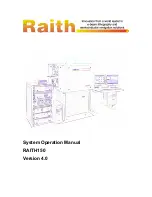
www.globalplasmasolutions.com
www.gpsair.com
For technical product queries, please reach out to [email protected]
Thank you for purchasing a GPS-iRIB® air ionization system from GPS Air. The GPS-iRIB is a highly versatile device
designed to be installed on the coiling coil of ductless systems or PTACs. The units can be installed on systems where
there may not be enough room between the filter and the coil for traditional GPS products. The units come with adhe-
sive-backed hook and loop tape for ease of installation.
As part of the installation process, a Startup Document should be
completed. For the latest version of the document, visit our website
or utilize the QR code.
Ductless Mini-Split and PTAC Mounting and Wiring Instruction
1. Turn off the power to the air handling unit (AHU). Follow all local and national electrical and building codes.
2. Remove the filter screens and the cover to expose the coil surface and the power box.
3. Determine where you want to mount the ionization strip on the AHU.
4. Peel off the loop section from the GPS-iRIB and then peel off the paper layer to expose the adhesive.
5. Carefully attached the adhesive backed loop on the AHU at the desired location. Some mini split systems
come with a plastic strip along the top of the coil. If so, mount the GPS-iRIB to the plastic strip. Otherwise
mount the GPS-iRIB on the finned surface. See
FIGURE 1
.
CAUTION:
Keep the emitter tips away from loose wires or any grounded parts.
CAUTION:
MAKE SURE POWER IS DISCONNECTED TO THE HVAC EQUIPMENT BEFORE INSTALLATION
6. Each AHU brand will have different space constraints for the power supply. Find an appropriate space to
mount the power supply using the included hook and loop tape. Press the power supply firmly to the mount-
ing location. See FIGURE 1.
7. Run the wires to the electrical compartment. Connect the black wire to 100-240VAC and the white wire to
neutral. For 208-240VAC installations, connect the white wire to the other hot leg, depending on the power
supplied.
8. Trim the wires to length and connect to the appropriate power terminals, normally L1 and L2. Secure wires
properly with wire ties or other NEC approved methods.
!
!























